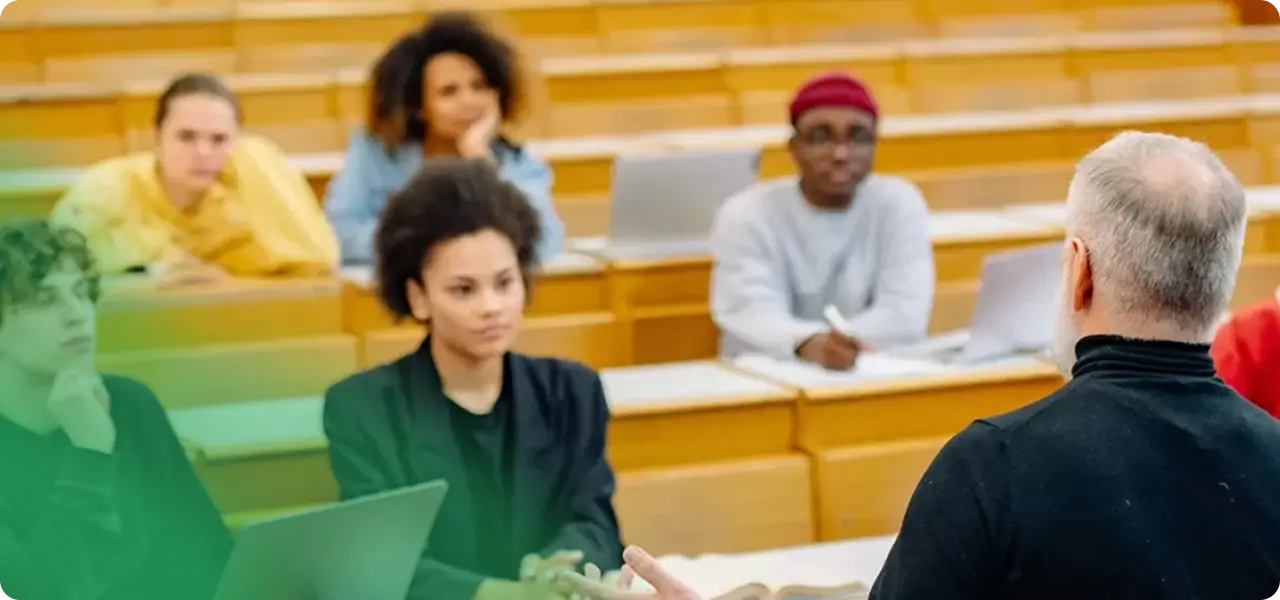- Education
Enhance Hybrid Learning Technology That Powers Higher Education

Video conferencing, a video management system, and a learning management system comprise “the Big Three” or “Holy Trinity” of higher education hybrid learning technology.
In a post-pandemic world, these technologies have given rise to new forms of learning that blend in-person and online instruction, as well as synchronous and asynchronous learning. Institutions are doubling down on these tools to enhance the overall educational experience and offer a hybrid learning environment.
We gathered educational technology leaders from the University of Arizona, Skyline College, and the University of Notre Dame to get their thoughts on the impact of technology in the classroom and the rise of hybrid learning at higher education institutions.
Here are the six main takeaways.
1. Learning technologies adopted during the pandemic continue to add value
When traditional in-person instruction was no longer an option at higher education institutions due to the pandemic, faculty across the country turned to learning technologies – primarily video conferencing (VC), a learning management system (LMS), and a video management system (VMS). These technologies allowed instructors to continue the classroom experience, although it may have looked a bit different than before.
At Notre Dame, a primarily residential and in-person learning institution, faculty made the shift to virtual teaching. This shift required an increase in lecture halls equipped with learning technologies, integration of the technology ecosystem, and the creation of a coworking professional development model that allowed faculty to share their learnings with one another and work together to find the most effective use of these technologies in the classroom.
Now that technologies are integrated into classrooms, their use will continue now and in the future.
2. Hybrid learning increased adoption of hybrid learning technologies
The pandemic drove a need for higher usage of learning technologies across the country and at all types of higher education institutions. From increased usage of video conferencing systems to the need for higher levels of video storage, the pandemic certainly increased the desire to integrate learning technologies within the classroom.
Even if VC, a VMS, and an LMS were available at a higher education institution prior to the pandemic, academic technologists found that the usage of these technologies skyrocketed. The University of Arizona made note that prior to the pandemic, they would only have about 10 faculty in a training session. Once the pandemic hit, faculty adoption grew, and hundreds of faculty would attend training sessions. Learning technologies have shifted from a “nice to have” to a “need to have” feature within classrooms, and now that faculty are more comfortable, we will continue to see the trend of learning technologies in the classroom.
3. Hybrid learning technologies allow greater insight
The increased usage of learning technologies also allowed instructors greater insight into student outcomes. With online learning tools, instructors can review insights such as how many times a student logs in to a platform, how long students spend on a certain page in an online book, whether or not a student watched an instructional video, and more.
Panopto’s video management system offers analytics that allow higher education faculty the insight they need to help increase student outcomes. Skyline College has seen an increase in inquiries regarding these analytics. For example, a music composition class instructor used video analytics to note that multiple students paused and rewatched a certain part of an instructional video. This insight allowed the instructor to recognize that students were struggling, which resulted in the creation of a new video that reviewed this particularly difficult concept.
4. Students want and expect video learning
In-person and virtual students all deserve equal attention and engagement in the teaching and learning process – and video helps this engagement happen. The University of Notre Dame notes that students are immersed in different types of multimedia in their daily lives, and they’ve come to expect this from their learning institutions as well. There’s a disconnect when students are using advanced forms of technology outside of the classroom but come to classrooms that only have a whiteboard or chalkboard. Integrating learning technologies within the classroom can close that gap and allow higher engagement with students by meeting them where they are. To remain competitive, higher education institutions will need to meet these evolving student expectations.
5. Faculty learn best from each other
The shift to HyFlex learning, a hybrid-flexible approach that allows students to choose and move between in-person and online participation, can be overwhelming. Coming back from the pandemic, faculty are now outfitted with multiple pieces of technology and may have a difficult time integrating these technologies into their new teaching pedagogies.
Dealing with students both in class and virtually doesn’t have to be a challenge, though. Academic technologists have learned that the best form of instruction can sometimes come from their peers. Academic technologists at the University of Arizona note that while they are showcasing what technologies are available to faculty and what they can do, faculty have taken the opportunity to learn from each other about what works best for their teaching styles and pedagogical approach. Through peer support, the shift to HyFlex learning is a bit smoother.
6. HyFlex learning is here to stay
If there’s one main takeaway from this conversation, it’s this – HyFlex learning is here to stay.
Academic technology leaders aren’t forcing this move, either. At the University of Arizona, a survey showed 97% of faculty were willing to move away from physical in-class clickers to technology on their phones. Instructors are now asking themselves, “What can we do when we physically come together versus what can be done asynchronously?”
Skyline College also noted that technology is simply becoming more and more integrated into what they do. Learning opportunities should be available both in person and virtually, and students and faculty expect to see this in higher education institutions.



